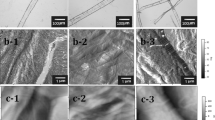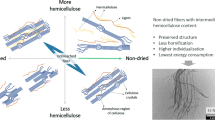Abstract
Laboratory mechanical softwood pulps (MSP) and commercial bleached softwood kraft pulps (BSKP) were mechanically fibrillated by stone grinding with a SuperMassColloider®. The extent of fibrillation was evaluated by SEM imaging, water retention value (WRV) and cellulase adsorption. Both lignin content and mechanical treatment significantly affected deconstruction and enzymatic saccharification of fibrillated MSP and BSKP. Fibrillation of MSP and BSKP cell walls occurs rapidly and then levels off; further fibrillation has only limited effect on cell wall breakdown as measured by water retention value and cellulase adsorption. Complete (100 %) saccharification can be achieved at cellulase loading of 5 FPU/g glucan for BSKP after only 15 min fibrillation with energy input of 0.69 MJ/kg. However, the presence of lignin in MSP affects the extent of fibrillation producing fibrils mainly above 1 μm. Lignin binds nonproductively to cellulases and blocks cellulose thereby reducing its accessibility. As a result, the cellulose saccharification efficiency of MSP fibrils (6 h of fibrillation, energy input of 13.33 MJ/kg) was only 55 % at same cellulase loading of 5 FPU/g glucan.







Similar content being viewed by others
References
Agarwal UP, Reiner RS, Ralph SA (2010) Celulose I crystallinity determination using FT-Raman spectroscopy: univariate and multivariate methods. Cellulose 17(4):721–733
Ahola S, Turon X, Österberg M, Laine J, Rojas OJ (2008) Enzymatic hydrolysis of native cellulose nanofibrils and other cellulose model films: effect of surface structure. Langmuir 24(20):11592–11599
Besbes I, Alila S, Boufi S (2011) Nanofibrillated cellulose from TEMPO-oxidized eucalyptus fibres: effect of the carboxyl content. Carbohydr Polym 84(3):975–983
Bozell JJ, Petersen GR (2010) Technology development for the production of biobased products from biorefinery carbohydrates: the US department of energy’s “top 10” revisited. Green Chem 12(4):539–554
Chai X-S, Zhu JY, Li J (2001) A simple and rapid method to determine hexeneuronic acid groups in chemical pulps. J Pulp Paper Sci 27(5):165–170
Cheng Q, Wang S, Rials TG, Lee SH (2007) Physical and mechanical properties of polyvinyl alcohol and polypropylene composite materials reinforced with fibril aggregates isolated from regenerated cellulose fibers. Cellulose 14(6):593–602
Dasari RK, Berson RE (2007) The effect of particle size on hydrolysis reaction rates and rheological properties in cellulosic slurries. Appl Biochem Biotechnol 137:289–299
Dekker J (2003) New insights in beating leading to innovative beating techniques. PIRA 2003 refining conference, Stockholm, Sweden
Endo T (2010) Bioethanol production from woods with the aid of nanotechnology. Synthesiology 4(2):270–281
Gupta R, Lee YY (2009) Pretreatment of hybrid poplar by aqueous ammonia. Biotechnol Prog 25:357–364
Hartman RR (1985) Mechanical treatment of pulp fibers for paper property development. In: Punton V (ed) The 8th fundamental research symposium: paper making materials. Mechanical Engineering Publications Limited, Oxford, pp 413–442
Henriksson M, Berglund LA, Isaksson P, Lindström T, Nishino TD (2008) Cellulose nanopaper structures of high toughness. Biomacromolecules 9:1579–1585
Himmel ME, Ding SY, Johnson DK, Adney WS, Nimlos MR, Brady JW, Foust TD (2007) Biomass recalcitrance: engineering plants and enzymes for biofuels production. Science 315(5813):804–807
Hu F, Jung S, Ragauskas A (2012) Pseudo-lignin formation and its impact on enzymatic hydrolysis. Bioresour Technol 117:7–12
Iwamoto S, Nakagaito AN, Yano H (2007) Nano-fibrillation of pulp fibers for the processing of transparent nanocomposites. Appl Phys Mater Sci Process 89:461–466
Kallavus U, Gravitis J (1995) A comparative investigation of the ultrastructure of steam exploded wood with light, scanning and transmission electron-microscopy. Holzforschung 49(2):182–188
Kerekes RJ (2005) Characterizing refining actions: linking the process to refining results. In: PIRA 2005 refining conference, Barcelona, Spain
Koo BW, Treasure TH, Jameel H, Phillips RB, Chang HM, Park S (2011) Reduction of enzyme dosage by oxygen delignification and mechanical refining for enzymatic hydrolysis of green liquor-pretreated hardwood. Appl Biochem Biotechnol 165(3–4):832–844
Laine J, Stenius P (1997) Effect of charge on the fiber and paper properties. Pap Puu 79:257–266
Lan TQ, Lou H, Zhu JY (2012) Enzymatic saccharification of lignocelluloses should be conducted at elevated pH 5.2–6.2. BioEner Res. doi:10.1007/s12155-012-9273-4
Lee SH, Chang F, Inoue S, Endo T (2010) Increase in enzyme accessibility by generation of nanospace in cell wall supramolecular structure. Bioresour Technol 101(19):7218–7223
Leu S-Y, Zhu JY (2012) Substrate related factors affecting enzymatic saccharification of lignocelluloses: our recent understanding. BioEner Res. doi:10.1007/s12155-012-9276-1
Liu H, Zhu JY, Chai XS (2011) In situ, rapid, and temporally resolved measurements of cellulase adsorption onto lignocellulosic substrates by UV-vis spectrophotometry. Langmuir 27(1):272–278
Luo X, Zhu JY (2011) Effects of drying-induced fiber hornification on enzymatic saccharification of lignocelluloses. Enzym Microb Technol 48(1):92–99
Luo X, Gleisner R, Tian S, Negron J, Horn E, Pan XJ, Zhu JY (2010) Evaluation of mountain beetle infested lodgepole pine for cellulosic ethanol production by SPORL pretreatment. Ind Eng Chem Res 49(17):8258–8266
Luo X, Zhu JY, Gleisner R, Zhan HY (2011) Effect of wet pressing-induced fiber hornification on enzymatic saccharification of lignocelluloses. Cellulose 18:1339–1344
Mansfield SD, Mooney C, Saddler JN (1999) Substrate and enzyme characteristics that limit cellulose hydrolysis. Biotechnol Prog 15:804–816
Martin-Sampedro R, Filpponen I, Hoeger IC, Zhu JY, Laine J, Rojas OJ (2012) Rapid and complete enzyme hydrolysis of ligocellulosic nanofibrils. ACS Macro Lett 1(1):1321–1325
Perlack RD, Wright LL, Turhollow A, Graham RL, Stokes B, Erbach DC (2005) Biomass as feedstock for a bioenergy and bioproducts industry: The technical feasibility of a billion-ton annual supply. Oak ridge national laboratory report, ORNL/TM-2005/66, US Dept of Energy
Segal L, Creely JJ, Martin AE, Conrad CM (1959) An empirical method for estimating the degree of crystallinity of native cellulose using the X-ray diffractometer. Text Res J 29:786–794
Sewalt VJH, Glasser WG, Beauchemin KA (1997) Lignin impact on fiber degradation.3. Reversal of inhibition of enzymatic hydrolysis by chemical modification of lignin and by additives. J Agric Food Chem 45(5):1823–1828
Sinitsyn AP, Gusakov AV, Vlasenko EY (1991) Effect of structural and physico-chemical features of cellulosic substrates on the efficiency of enzymatic hydrolysis. Appl Biochem Biotechnol 30:43–59
Siwiö J, Kärenlampil P (1998) Pits as natural irregularities in softwood fibers. Wood Fiber Sci 30:27–39
Spence KL, Venditti RA, Rojas OJ, Habibi Y, Pawlak JJ (2011) A comparative study of energy consumption and physical properties of microfibrillated cellulose produced by different processing methods. Cellulose 18(4):1097–1111
Sun Y, Cheng JY (2002) Hydrolysis of lignocellulosic materials for ethanol production: a review. Bioresour Technol 83(1):1–11
TAPPI (2009) TAPPI test methods. Technical Association of the Pulp and Paper Industry, Atlanta
Wang QQ, He Z, Zhu Z, Zhang Y-HP, Ni Y, Luo XL, Zhu JY (2012a) Evaluations of cellulose accessibilities of lignocelluloses by solute exclusion and protein adsorption techniques. Biotechnol Bioeng 109(2):381–389
Wang QQ, Zhu JY, Gleisner R, Kuster TA, Baxa U, McNeil SE (2012b) Morphological development of cellulose fibrils of a bleached eucalyptus pulp by mechanical fibrillation. Cellulose 19(5):1631–1643
Wang ZJ, Zhu JY, Gleisner R, Chen KF (2012c) Ethanol production form poplar wood the rough enzymatic saccharification and fermentation by dilute acid and SPORL pretreatments. Fuel 95:606–614
Weise U, Maloney T, Paulapuro H (1996) Quantification of water in difference states of interaction with wood pulp fibres. Cellulose 3:189–202
Zhu JY (2011) Physical pretreatment—woody biomass size-reduction—for forest biorefinery. In: Zhu JY, Zhang X, Pan XJ (eds) Sustainable production of fuels, chemicals, and fibers from forest biomass. American Chemical Society, Washington, pp 89–107
Zhu J, Wang G, Pan X, Gleisner R (2009a) Specific surface to evaluate the efficiencies of milling and pretreatment of wood for enzymatic saccharification. Chem Eng Sci 64(3):474–485
Zhu JY, Pan XJ, Wang GS, Gleisner R (2009b) Sulfite pretreatment (SPORL) for robust enzymatic saccharification of spruce and red pine. Bioresour Technol 100(8):2411–2418
Zhu W, Zhu JY, Gleisner R, Pan XJ (2010) On energy consumption for size-reduction and yield from subsequent enzymatic sacchrification of pretreated lodgepole pine. Bioresour Technol 101(8):2782–2792
Zhu JY, Luo X, Tian S, Gleisner R, Negrone J, Horn E (2011a) Efficient ethanol production from beetle-killed lodgepole pine using SPORL technology and Saccharomyces cerevisiae without detoxification. Tappi J 10(5):9–18
Zhu JY, Verrill SP, Liu H, Herian VL, Pan XJ, Rockwood DL (2011b) On polydispersity of plant biomass recalcitrance and its effects on pretreatment optimization for sugar production. BioEner Res 4(3):201–210
Acknowledgments
This work was sponsored by the USDA Forest Service R&D special funding on Cellulose Nano-Materials (2012).
Author information
Authors and Affiliations
Corresponding author
Additional information
This work is conducted on official government time of Zhu while Hoeger and Nair were visiting scientists at the USDA Forest Service, Forest Products Laboratory.
Rights and permissions
About this article
Cite this article
Hoeger, I.C., Nair, S.S., Ragauskas, A.J. et al. Mechanical deconstruction of lignocellulose cell walls and their enzymatic saccharification. Cellulose 20, 807–818 (2013). https://doi.org/10.1007/s10570-013-9867-9
Received:
Accepted:
Published:
Issue Date:
DOI: https://doi.org/10.1007/s10570-013-9867-9




